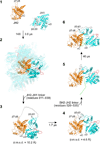Molecular basis for pseudokinase-dependent autoinhibition of JAK2 tyrosine kinase
- PMID: 24918548
- PMCID: PMC4508010
- DOI: 10.1038/nsmb.2849
Molecular basis for pseudokinase-dependent autoinhibition of JAK2 tyrosine kinase
Abstract
Janus kinase-2 (JAK2) mediates signaling by various cytokines, including erythropoietin and growth hormone. JAK2 possesses tandem pseudokinase and tyrosine-kinase domains. Mutations in the pseudokinase domain are causally linked to myeloproliferative neoplasms (MPNs) in humans. The structure of the JAK2 tandem kinase domains is unknown, and therefore the molecular bases for pseudokinase-mediated autoinhibition and pathogenic activation remain obscure. Using molecular dynamics simulations of protein-protein docking, we produced a structural model for the autoinhibitory interaction between the JAK2 pseudokinase and kinase domains. A striking feature of our model, which is supported by mutagenesis experiments, is that nearly all of the disease mutations map to the domain interface. The simulations indicate that the kinase domain is stabilized in an inactive state by the pseudokinase domain, and they offer a molecular rationale for the hyperactivity of V617F, the predominant JAK2 MPN mutation.
Figures





References
Publication types
MeSH terms
Substances
Grants and funding
LinkOut - more resources
Full Text Sources
Other Literature Sources
Miscellaneous

